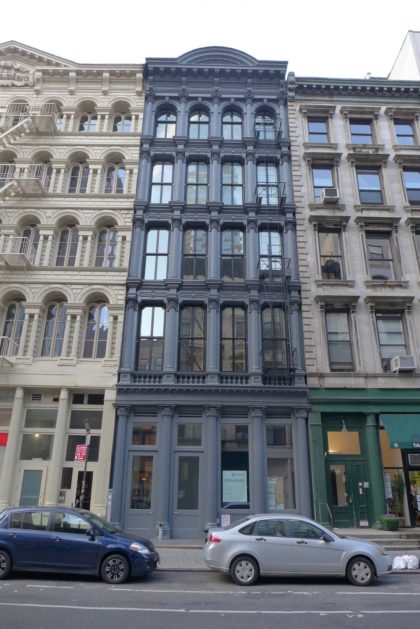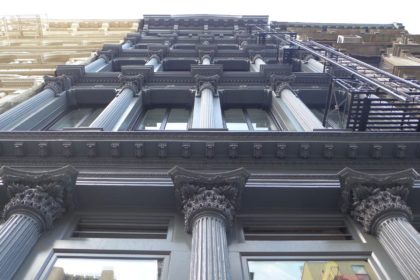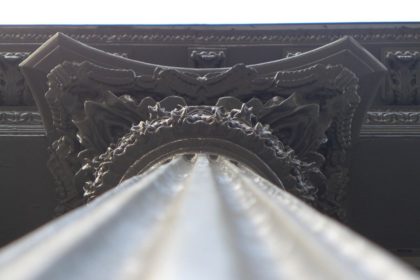The History of 93 Reade
 Tom Miller, who writes about the history of Manhattan buildings at Daytonian in Manhattan, has allowed Tribeca Citizen to create a database of his Tribeca posts. If you enjoy these, and you will, then you should definitely check out his website, which also has write-ups about buildings all over the island. And don’t miss his book, Seeking New York: The Stories Behind the Historic Architecture of Manhattan—One Building at a Time.
Tom Miller, who writes about the history of Manhattan buildings at Daytonian in Manhattan, has allowed Tribeca Citizen to create a database of his Tribeca posts. If you enjoy these, and you will, then you should definitely check out his website, which also has write-ups about buildings all over the island. And don’t miss his book, Seeking New York: The Stories Behind the Historic Architecture of Manhattan—One Building at a Time.
··································
 In 1714 Queen Anne bestowed on Trinity Church a vast section of land stretching along the Hudson River from Duane Street to Christopher Street in the Village of Greenwich to the north. The large tract of land became familiarly known as the “Trinity Farm” or the “Church Farm.” Initially the church leased land to farmers; but in 1761 the city ceded the land between Fulton and Reade Streets to the city (Reade Street was most likely named for Trinity Church warden Joseph Reade.)
In 1714 Queen Anne bestowed on Trinity Church a vast section of land stretching along the Hudson River from Duane Street to Christopher Street in the Village of Greenwich to the north. The large tract of land became familiarly known as the “Trinity Farm” or the “Church Farm.” Initially the church leased land to farmers; but in 1761 the city ceded the land between Fulton and Reade Streets to the city (Reade Street was most likely named for Trinity Church warden Joseph Reade.)
Reade Street and its neighboring streets like Chambers were lined with upscale brick homes by the first decades of the 19th century. Among the wealthy families here were the Joneses at No. 93 Reade Street. Isaac Jones, Jr. was the partner of John Mason, the “father of the Chemical Bank.” Jones married Mason’s daughter, Mary, in 1819. Mary Mason Jones would reign as the queen of New York society for decades.
The couple had four children, Joshua, John, Margaret and Frances. By 1839 the recently-exclusive neighborhood already was seeing the encroachment of commerce. That year the Jones family moved to north to No. 734 Broadway. When Isaac Jones died on March 14, 1854, the Reade Street property was inherited by Joshua.
The residence was already the home of James H. Shaw’s jewelry business by 1843. His was just one of several jewelry and silversmith businesses on Reade and Chambers Streets at the time. But three years after inheriting the property, Joshua Jones had it razed to be replaced with a modern commercial building.
In 1857 a new technology was taking hold—cast iron facades. For a decade former watchmaker and “machinest,” James Bogardus had been experimenting with pre-fabricated cast iron elements. These could be quickly bolted to the brick fronts of buildings, could imitate carved stone, be easily cast with elaborate decorative elements and—most importantly—would be fireproof. By now the process had been perfected and cast iron facades were quickly gaining widespread acceptance.
Jones’ new five-story building was fronted with a cast iron façade chosen from the catalogue of D. D. Badger’s Architectural Iron Works. The Italianate-style design mimicked stone-fronted buildings with its fluted Corinthian columns, dentiled cornices, handsome balustrades at the second floor and leafy keystones at the top floor.
The new building filled with dry goods and apparel firms. In 1867 Griffith, Prentiss & McCombs was here, listed as “dry goods importers;” as were R. Waterhouse & Co., “gents’ furnishings goods;” and Charles L. Lockwood, necktie manufacturer.
By 1876 Jacob Basch & Son was in the building. Jacob and his son, Henry L. Basch, dealt in the woolen fabric known as “shoddy.” The inferior quality textile was constructed from the shredded fibers of waste cloth or clippings and eventually lent its name to any inferior product—called shoddy goods. The firm remained at No. 93 until its bankruptcy in 1884.
A merchant not involved in textiles was B. W. Sheldon & Dimscomb which was in the building by 1879. Sylvester W. Sheldon and his partner, Daniel Dimscomb, dealt in grocers’ woodenware and fixtures. Sheldon, who was a descendant of General Israel Putnam, a hero of Bunker Hill, had invented several mechanical appliances.
In February 1889 the estate of Joshua Jones sold No. 93 to John H. Ireland for $57,000—around $1.5 million in 2016. According to Ireland later, it “was in pretty good order when I bought it.” He reported his gross rents that year at $4,400. He also reported in 1893 that he replaced the roof and “It is an iron front and required painting. That is about all that has been done.”
B. W. Sheldon & Dimscomb was still in the building when Ireland bought it; but the rest of the tenant list reflected a marked change in the district’s industry. The four other firms in the upper stories were all in the boot and shoe business. These included Baldwin & Lamkin, Kelly & Tracy, and Bielefeld & Spahn.
Millers Falls Company had been in the store space for several years. The company dealt in cutlery and carving tools. When Millers Falls introduced a new 12-piece boxed carving set in December 1898, Hardware magazine assured its readers it would “prove an element of happiness in the shop or household during the holiday season.”
It appears that S. W. Sheldon & Dimscomb left No. 93 Reade Street following Sylvester Sheldon’s unexpected death in April 1895 at the age of 56.
 The shoe manufacturing firms were still operating from the upper floors and Millers Falls Company was in the store as the turn of the century came and went. The comfortable arrangement changed on January 17, 1905 when John H. Ireland leased the entire building to Wilhelmi, Hall & Co. for three years. The rent was $5,000 for the first year and $5,500 each year for the balance. What seemed like a good deal for Ireland became a major headache.
The shoe manufacturing firms were still operating from the upper floors and Millers Falls Company was in the store as the turn of the century came and went. The comfortable arrangement changed on January 17, 1905 when John H. Ireland leased the entire building to Wilhelmi, Hall & Co. for three years. The rent was $5,000 for the first year and $5,500 each year for the balance. What seemed like a good deal for Ireland became a major headache.
The newly formed firm, headed by Edward A. Wilhelmi, dealt in “American made machinery and general merchandise specialties.” On March 30, 1905 Iron Age reported “The entire building at 93 Reade street, containing five floors and two basements, has been taken and fitted up, complete samples of all the goods…being displayed for examination, the ample room also enabling the company to carry stocks.”
The firm seemed, at least initially, to be doing well. In August 1906 the Cold Storage and Ice Trade Journal reported that Wilhemi, Hall and Company would equip the new Commercial Trust Building at No. 15 Exchange Place with an 8-ton refrigerating plant “for cooling drinking water;” and that the firm had received a contract for a refrigerating machine for the Naval Academy in Annapolis.
The firm took advantage of the privilege of early renewal of the lease on November 19, 1906. But it was an over-optimistic move. In January 1907 Wilhemi, Hall and Company explained to Ireland that it needed to sublease the building. New York House Furnishing Goods Company was interested in the lease, it explained.
Sadly for Ireland, none of the negotiations worked out, and Wilhelmi, Hall & Co. was soon gone. According to court papers later, on May 11, 1908 John Ireland said in a letter to Edward Wilhelmi, “I am stuck on the building at 93 Reade Street—have not yet found a tenant. It is too bad that I had anything to do with #93 Reade Street, it was an expensive proposition. If you know of anybody who wants that building, I would thank you for mentioning it.”
A month earlier a bankruptcy sale of Wilhelmi, Hall & Company’s stock had been held in the building. An announcement in the New-York Tribune on April 26, 1908 listed “Entire Stock: refrigerators and general housefurnishings at a little advance on the prices ordered by the Court.”
The building finally rebounded and in 1910 The Shoe and Leather Reporter listed three shoe manufacturers on the upper floors—Asher Bass, Samuel J. Glick and Harrisburg Shoe Mfg. Co.—while the retail space was home to the retail shoe store of M. H. Smith Co. The same tenants were still here as late as 1918.
In 1950 the hardware and glassware firm William Leinwand leased the entire building. Throughout most of the century the old iron-fronted structure suffered the abuse of time and the decline of the neighborhood. By the 1980s, when the Tribeca area was experiencing a rebirth, the elaborate cast iron capitals of the ground floor columns had been lost.
The turn-around came late for No. 93 Reade Street. In 2015 a renovation by the architectural firm of WORKac resulted in Obsidian House–containing three sprawling residences and a three-story penthouse, invisible from the street. Sculptor Michael Hansmeyer created replacement capitals for the columns. His design did not attempt to reproduce the originals; but are a “modern reinterpretation.”
The early cast iron façade of No. 93 Reade Street has been sympathetically restored. It is a splendid example of the technological advance in construction taking place in Manhattan in 1857.
 ··································
··································
Photo credits: Tribeca Citizen.












